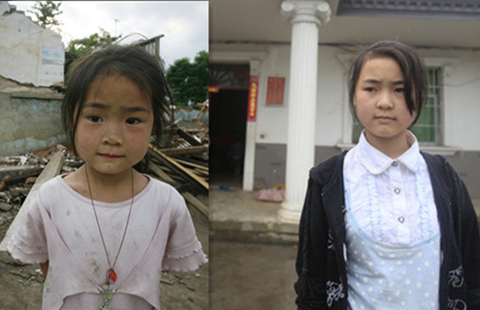
A number of artists have banded together to visit some of Beijing's poorest areas and highlight the lives of residents whose crucial role in the city's development is often overlooked. Tang Yue reports.
When a group of young Chinese artists and enthusiasts decided to act as an artistic version of Capital in the Twenty-First Century and examine the gap between the haves and have-nots, they chose to start by documenting the lives of those on the bottom rungs of the social ladder - Beijing's army of migrant workers.
Participants in the project, called "Between the Fifth and Sixth Ring Roads", were required to visit, or even better live in, one of the many villages dotted across the belt of land between the capital's two outermost ring roads for at least 10 days, and then tell the residents' stories in their own way. Since the project began in October, the lives of residents in 30 villages have been recorded, and a further three villages are under the microscope as the project is scheduled to end some time around June.
Ge Lei and three friends started the project as a protest against the "mainstream" art they believe is dictated by auction houses such as Sotheby's and Christie's. They say it's divorced from what they call "social reality" and is only fit to decorate the homes of the wealthy.
Migrant workers are important cogs in the wheels of modern Beijing. They build the subways and high-rise office towers, they cook and baby-sit, and do household chores for middle-class families. However, despite their integral role, they enjoy few of the fruits of the city's success, and the high cost of property and rents means they are forced to live on the outskirts, far from downtown and amenities.
Many of the newcomers live in old villages where the low-rise houses are shabby, hygiene is poor and utilities and services are inadequate. Their neighbors tend to be other migrant workers, elderly Beijing natives and recent graduates whose low wages mean they can't afford to live closer to the center. However, unlike the migrants and the elderly, the graduates have prospects.
There are no official statistics about the number of migrant workers in Beijing, but surveys conducted by sociology students suggest there may be between 3 million and 4 million, and according to one recent report, that figure includes 200,000 children.
Although artists are often regarded as drifters in Beijing (few have permanent resident status, or hukou), their work tends to be "highly commercialized", and some "produce only what sells best and pay no attention to society at all", said Ge, the project coordinator and co-founder of the nonprofit Second Floor Publishing House.
As an example, he pointed to the large number of artists who live cheek by jowl with migrant workers in the Heiqiao area but keep themselves closeted away in their studios and rarely engage with their neighbors.
Although China is now the world's No. 1 market for contemporary art sales, the work being produced fails to reflect people's daily lives, according to Ge Fei (no relation), one of the project's co-founders. "We joke that Chinese artworks have just become decorations for capitalists," he said.
Fight commercialization
Zhao Liang, a respected documentary filmmaker who was unable to participate in the project, was also critical of the contemporary art scene. "I don't think these artists are unaware of what's happening in society, and how hard the lives of migrant workers can be, but they have made conscious decisions to dodge reality. Some of them just enjoy wearing luxury brands and driving expensive cars," he said.
Paolo Magatnoli, a lecturer in contemporary arts at the University of Queensland in Brisbane, Australia, said the commercialization of art is a global phenomenon, but Chinese artists appear less interested in the real world.
According to the Italian national, who has lived and worked in Milan, New York, London and Sydney, Beijing's 798 Art Zone "is very commercialized, and very Westernized. The type of art there tends to be very international, but barely concerned with social issues."
Ge Lei said "Between the Fifth and Sixth Ring Roads" aims to bring artists closer to society. However, most of the participants are independent artists who work in the less-commercial spheres, and art students. "That's not surprising. We are not in the mainstream art circle, so it's natural that our project mainly appeals to birds of the same feather."
The four initiators - Ge Fei, Ge Lei, Li Yifan and Man Yu - have funded the project themselves. So far, they have spent less than 30,000 yuan ($4,800), mainly to cover the travel expenses of participants from outside Beijing, and their daily living costs.
The project has presented the artists with a series of challenges. Spending time with the migrant workers involved befriending and conversing with total strangers, and life in the villages can be hard, especially in winter when the lack of private bathrooms and efficient heating systems can drain enthusiasm and resolve.
"The biggest challenge is building up trust with the people you want to approach," Zhou Yanfeng, a participating sculptor, said. Inevitably, the young artists also encountered controversial aspects of village life, such as illegal (unregistered) kindergartens and the lowest levels of the sex industry. Other dangers lurked too. Documentary filmmaker Liu Weiwei claims he was physically assaulted by an official in Beisi village in Changping after he asked questions about local living conditions.
Li Renqing, a rural development scholar at the Chinese Academy of Social Sciences, said the project has great validity in reporting on the lives of migrant workers.
Li Yifan, who is an associate professor of oil painting at the Sichuan Institute of Fine Arts, said the project will help people who live in the better areas of Beijing to learn about life outside the fifth ring road.
However, as the French economist Thomas Piketty, author of Capital in the Twenty-First Century, pointed out, the inequality gap is hard to close.
At a seminar held by the organizers with some villagers in late March, Fan Yusu, a 41-year-old housekeeper, spoke up: "I've heard people mention equality quite a few times today. I dearly harbor the wish that the day will come when an artist talks to a migrant worker and doesn't adopt a superior approach, and the migrant worker won't feel inferior. I hope that all of you, and your work, can help to bring that day a little closer."
Contact the writer at tangyue@chinadaily.com.cn

|
A woman works at her roast duck business in Xibeimen village in Chaoyang district. |
|
Children of migrant workers attend a primary school in Banjieta village in Changping district. |
|
A woman passes houses rented by migrant workers in Banjieta village. Photos by Wang Tiewei and Dai Jianyong / for China Daily |

|
Beisi village photographed at 9 am and 9 pm on the same day. Wang Pan / for China Daily |
(China Daily 05/13/2015 page6)








